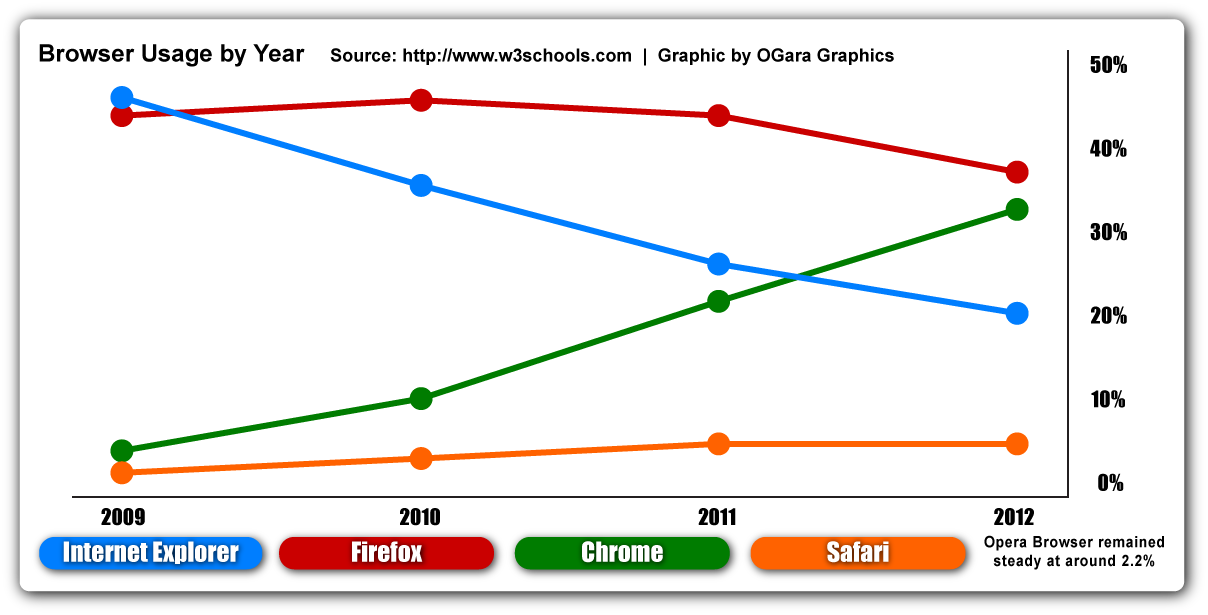


Why Web Designers hope Internet Explorer would just go away
Designing for different browsers
December 14, 2011
I'm not the first to say this, but my hope is that I'll be one of the last: If everyone just stopped using Internet Explorer, the country would be better off.
To be clear, I am not anti-Microsoft. I am not trying to start the usual pointless argument of Mac vs. PC. I use many different computers with various operating systems, and most brands of PCs using Windows are perfectly fine for most of your basic tasks. Ever since Apple's OS X, I prefer their computers in almost every way, but I am a graphic designer, not the average user. Most people don't need their computer to do as much as I do, so it wouldn't make sense for them to pay more for a device they're just going to use to browse the internet, watch videos, and maybe type a text document. We can discuss pros/cons of Mac/Windows another time.
There - disclaimer is out of the way, back to Internet Explorer. I'm just old enough to remember when your options for viewing websites seemed to be Internet Explorer (IE) or Netscape. Netscape never seemed to display web pages as well as IE, so after awhile I stopped using Netscape, and I'm guessing I'm not the only one who felt this way, because it gradually lost users to IE. Since Microsoft's browser is now in that same position, where it can't be trusted to display websites as well as the competition, I suggest it should go the way of Netscape, specifically that it should fade away or be re-designed & turned into a new browser.
As I understand it, Microsoft has always wanted to have their own version of HTML code, specific to IE. For instance, while every browser can understand a 6-digit number to represent a color on screen, IE had its own names for colors, which wouldn't necessarily work on other browsers. Years ago, almost everyone used IE, and Microsoft made what I consider to be a common mistake in this situation - they assumed they would always have the majority share of the web browser market, and therefore, the world should cater to the way they wanted to do things. For awhile, this attitude probably worked. Web designers could design with IE in mind and take advantage of specific features this browser would support which wouldn't work in other browsers (if only a small percentage of people are using a device/browser, they can be more easily ignored, even though I wouldn't recommend it in most cases).
The problem is, the internet is based around the idea that information should be more freely available, and many people (especially programmers) love open-source projects. Among these internet users, there was eventually a backlash against Microsoft (the "large, evil corportation") in favor of browsers like Firefox, built by people who listened to what their users wanted and allowed other programmers to customize the browser with widgets / add-ons. Eventually, Firefox proved this type of browser could be just as good or better than IE in terms of stability, security, and speed. Microsoft still had a chance to keep up, but instead, they gave us IE 6 (notoriously bad at rendering pages) and IE 7 (better?).
Currently, browsers operate using Web Standards, which are decided upon at conferences every so often and are made available so that anyone from a professional web designer to kids learning to make their first web page can look up the difference between HTML 4.01, XHTML 1.0, etc. and create websites which should look pretty much the same no matter how someone views it. Different browsers still implement specific features which they hope will catch on and eventually become a Standard. Good examples include Rounded Corners (radius) and Box Shadows, which are supported in Firefox, Chrome, and Safari but not IE (rounded corners are only supported in the latest version, IE 9). Sure, for some of these features, you still have to add slightly different "webkit" code to account for different browsers, but at least they give you a way to show web content the way you want.
Here is an example of a recent website I designed, and how it looked in different browsers when I first began testing it. As you can see, the nice rounded corners and shadows (which designers were begging for years to accomplish with HTML instead of additional image files) do not render in IE. Also, javascript code to grab & drag or zoom in/out on the map is also not supported in IE, but works perfectly in every other browser:
Now, in this case I was left with two options: either create an entirely different set of code and new graphics or elaborate third-party javascript code to simulate the rounded boxes with shadows (practically a whole new site) for IE users. Or, ignore these inconsistencies and let visitors using IE see an inferior site which doesn't really work the way it needs to. I wish we could ignore IE, but at least 20% of the country still uses this browser, so we really can't. It has been suggested that IE users will not care about these differences, but as a designer, I really want to make sure a website looks the way it is intended, and I'm sure developers and the end users would like a site to work the way it's intended as well.
Designing for the web has always been more challenging than designing for print. With a printed piece, you have control over exactly how it's going to look to every single person who sees it. A website, however, is interactive, and viewed with thousands of combinations of devices, browsers, screen sizes, and other variables which can be set by the end user (such as security settings, whether or not Javascript is turned on, etc). This interactive nature is both the challenge and the joy of designing for the web. Technically, when designing a website, you should account for all these factors, so pages will change depending on how someone needs to view them. I don't have a problem designing for different situations - I mean, since 2008, designers have had it pretty good in that we haven't had to worry about designing for people with less than a million colors on their monitor, or screen resolutions less than 1024x768. But, with the number of possible devices we need to cater to now and in the future (smart phones, tablets, internet-enabled TV, etc.), do we really need to go this far out of our way to make IE do things which every other browser accommodates perfectly?
I guess the solution is to just get everyone to quit using IE if Microsoft won't keep up with the quality of every other modern browser. Not easy to do, but not impossible. I think most people who still use IE do so because they don't know what they're missing, they're afraid to change, or they just use it because it's installed by default with every copy of Windows. I'm in a different position because I work on Macs & PCs, and I'm testing against various browsers all the time, so I don't have just one "go-to browser" I use every time I'm online. However, I assume most people only install and use one browser for all online interaction, so if you can convince people to switch voluntarily, the new browser will be their default for a long time.
Another reason designers have such problems with IE is that it doesn't support older operating systems as well as other browsers. For instance, if a security update is necessary, or some new features are developed, Firefox, Chrome, and Safari all create updates which work on the latest devices and all the way back to people using Windows XP (or for Mac users, OS X 10.5). IE 9 (the latest version at the time of this article) will work with Windows 7 and Vista, but only version 8 works with Windows XP. Sure, some of the issues with IE will eventually go away as people get new computers and upgrade from Windows XP, but then we're still stuck with IE 9, and for now, about 32% of people are still using Windows XP. Also, I am not one of these people who expects everyone to upgrade their computer/phone/TV every time something new comes along. This is the beauty of getting people to switch to a different browser - they don't have to upgrade their whole computer just to get the advantages of an updated browser.
I really wish IE would have just kept up - since we had Firefox, I don't think there was really a need for Google to come out with their own browser (and I don't even think Chrome is that great), but since Android-powered devices seem to be here to stay, we have to assume the number of people using that browser will continue to increase in the near future. But, from a design standpoint, we really need to know that websites are going to work in a somewhat predictable way. I guess the good news for designers/developers is that even if we don't actively convince people to move away from IE, they may continue to do so anyway, with the rise of mobile devices which come with different default web browsers. IE usage has dropped about 10% per year since the rise of Firefox and Chrome, as this graphic shows:
When I say that the country would be better if people stopped using Internet Explorer, I'm not suggesting that it would solve the country's problems. It would, however, save time for a lot of web designers and developers, allow businesses to get more done, and the average internet user's web experience would be significantly better. I really think it's time for IE to finally go, if Microsoft doesn't feel like keeping up with the latest and greatest innovations in web design.
Matt O'Gara
Owner, OGara Graphics











